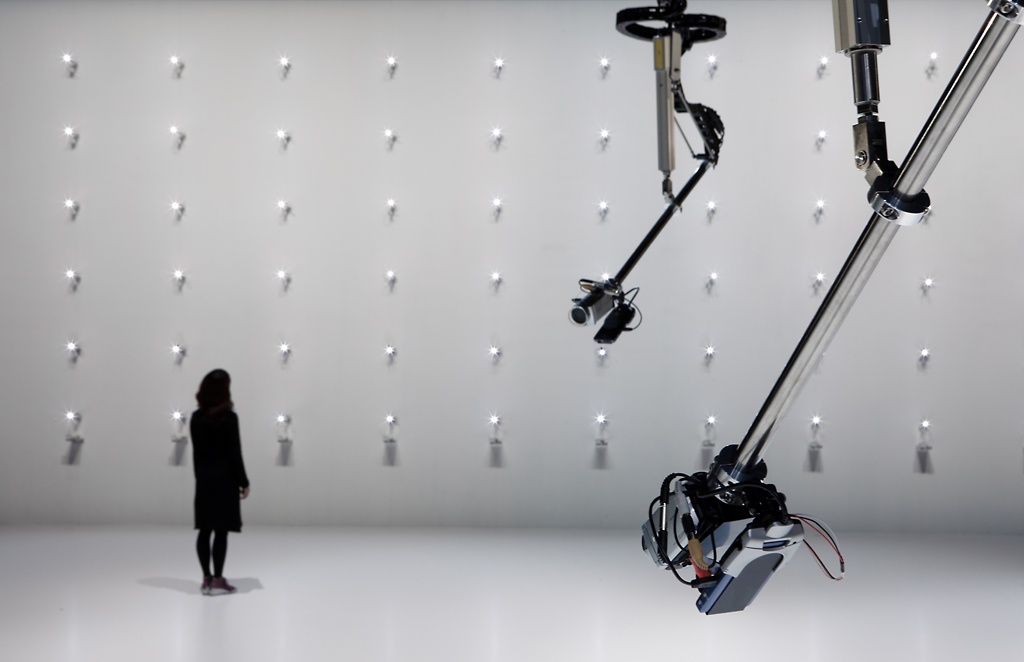Seiko Mikami “Desire of Codes”
March 20 – June 6, 2010
installation / commissioned by YCAM
Desire of Codes (YCAM Re-Marks)
Outline
This large-scale installation investigates the forms of human corporeity and desire facilitated by surveillance technology and network society. It is comprised of three parts – a wall with a large number of devices (”90 Wriggling Wall Units”), six robotic “search arms” suspended from the ceiling to follow visitors (”6 Multiperspective Search Arms”), and a huge semi-spherical screen composed of 61 hexagonal cells (”Compound Eye Detector Screen”) – the work incorporates various systems that generate complex interaction between the respective parts’ images and sounds. The YCAM InterLab team designed and produced various mechanisms and sound generation systems based on the ideas of the work’s creator, Seiko Mikami. In order to further expand the general concept, a system that allows higher-order interaction was devised to reciprocally interlock the interaction between the visitor and each of the work’s components.
Developmental accomplishments
Development/design of robotic search arms
Search arms fitted with video cameras and projectors continue to film the visitor while following his/her movements, and simultaneously projecting the recorded footage. These arms were co-developed by the YCAM InterLab team and Ryota Kuwakubo. Kuwakubo was in charge of designing circuits and developing software for controlling the arms, while YCAM InterLab took over the circuit and sensor communication protocol, and the design and development of the drive mechanism. The drive mechanism was designed around a combination of step motors and servo cylinders to prevent the built-in video cameras and projectors from turning upside down. In addition, parts used in high-torque industry robots were employed to enable the search arms to respond instantaneously and precisely when a visitor approaches the area, and point their ends in the direction of that visitor.
Construction of a sound generation system
A special system was devised to continuously record via shotgun microphones various sounds inside the exhibition space, such as noises and voices of visitors, as well as the machine noises of the wall devices and search arms, and store the collected data together with data of sound pressure and frequency components in a database. Also developed was software for the generation and processing of sounds utilizing audio sources from that database. With this software, previously recorded audio files were culled from the database and used, retrieved based on criteria such as noises caused by visitors, and the states (response/standstill) of the three individual parts of this work (”90 Wriggling Wall Units”, ”6 Multiperspective Search Arms”, ”Compound Eye Detector Screen”). Eight speakers and four subwoofers were used for the playback of sounds generated by this system, carefully tuned and arranged in a layout designed to let the sounds “float” across the entire exhibition space.
Construction of an imagery/sound/light interaction system
A system that allows higher-order interaction was devised to reciprocally interlock the interaction between the visitor and each of the work’s components, in addition to interaction that emerges from the relationship between the visitor and the work at large. This system was used to continuously gather angle measurements and sensor data from each of the 15 rows of devices in ”90 Wriggling Wall Units”, vertical angle values of the servo cylinders and horizontal angle values of the step motors in ”6 Multiperspective Search Arms”, and numerical data indicating the ratio of categories displayed in the 61 cells (single eyes) in ”Compound Eye Detector Screen” as image/sound/light parameters and trigger factors. These ultimately controlled the autonomous updating of the ”Compound Eye Detector Screen”, determining the timing of the sounds created by the sound generation system, and illumination of the search arms and wall structure, as well as effects such as the shifting of the sound image in the exhibition space.
Technical Credits
Artworks、Concept : Seiko Mikami
Development for Search Arms Device : Ryota Kuwakubo
Programming for the compound eye detector screen : Norimichi hirakawa
Development for the wriggling wall : TAKEGAHARASEKKEI:
Programming for the wriggling wall : Sota Ichikawa:
Special Cooperation : Akihiro Kubota , Junshi Horiguchi
Corporate sponsors: AD Science Co., Microvision, Inc.
Cooperation: Tama Art University Media Art Lab. , Perfektron LLC.
YCAM InterLab
Technical Direction、Spatial Design: Soichiro Mihara
Mechanical Design for Search Arms Device : Richi Owaki
Sound Plan , Sound&Light Programming : Satoshi Hama
Lighting Design : Fumie Takahara
Spatial Construction : Takuro Iwata , Mitsuo Uno








